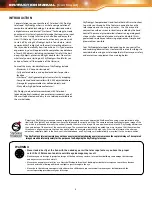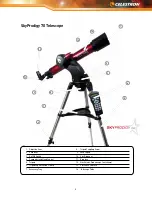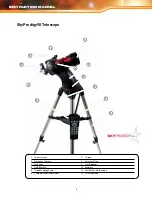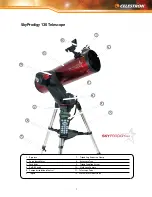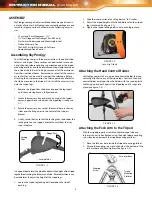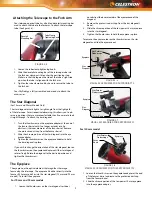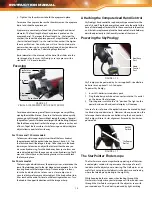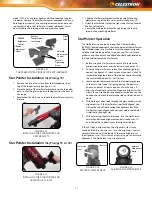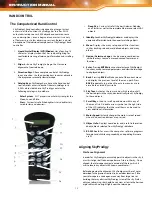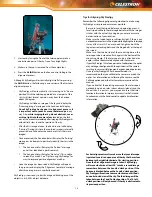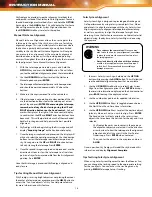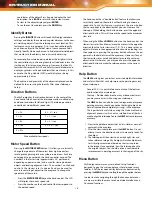
displayed when the IDENTY button is pressed. This will not only
allow you to set the brightness of the object you want SkyProdigy
to identify but also the distance away from its current location.
• The Identify Filter can be set between 0 (very bright objects)
and 25.5 (extremely faint objects)
• The search radius filter can be set from 0° to 25.5°
Press ENTER to accept the value.
Allow Sun – This menu allows you to enable the Sun as an object
that will be displayed under the Solar System object catalog and
that can be used when using the Solar System alignment option.
Use the UP and DOWN Scroll buttons to toggle between “yes”
and “no” and press ENTER to accept.
Telescope Setup
Tracking - In addition to being able to move the telescope with the
hand control buttons, SkyProdigy will continually track a celestial
object as it moves across the night sky. The tracking rate can be
changed depending on what type of object is being observed:
Sidereal
This rate compensates for the rotation of the Earth
by moving the telescope at the same rate as the
rotation of the Earth, but in the opposite direction.
Lunar
Used for tracking the Moon when observing the
lunar landscape.
Solar Used for tracking the Sun when solar observing
using a proper solar filter.
Disable
Turn tracking completely off.
Slew Limits – Sets the limits in altitude that the telescope can
slew. The slew limits prevent the telescope tube from slewing to
an object below the horizon or slewing to an object that is high
enough that the tube might hit one of the tripod legs. However,
the slew limits can be customized depending on your needs. For
example, if you would like to slew to an object that is close to the
zenith and are certain that the tube will not hit the tripod legs, you
can set the maximum slew limits to 90º in altitude. Setting your
limits to 0 and 90° will allow the telescope to slew to any object
above the horizon. Use the UP/DOWN Scroll buttons to increase
or decrease the numeric value from 0 to 90°. Press ENTER to
accept the values. Press BACK to exit the menu.
Direction Buttons – The direction a star moves in the eyepiece
varies depending on the optical accessories being used. This feature
can be used to change the direction that the stars moves in the
eyepieces when a particular arrow button is being pressed. To
reverse the button logic of the direction keys, press the MENU
button and select Direction Buttons from the Telescope Setup menu.
Use the ENTER button to select either the Azimuth buttons (left
and right) or Altitude buttons (up and down). Pressing the UP
and DOWN Scroll buttons to reverse the direction of the hand
control buttons from their current state. Press BACK to exit the
menu. Direction Buttons will only change the eyepiece rates
(rate 1-6) and will not affect the slew rates (rate 7-9).
Cordwrap – Cordwrap safeguards against the telescope slewing
more than 360º in azimuth and wrapping cables around the
base of the telescope. This is useful any time that the telescope
is powered using an external power supply. By default, the cord
wrap feature is turned on.
There may be a time when the telescope may not slew to an
object from the shortest distance but instead slew to the object
from the opposite direction. This is normal and necessary to
prevent power cord from wrapping around the telescope.
Backlash Compensation – All mechanical gears have a certain
amount of backlash or play between the gears. This play is
evident by how long it takes for a star to move in the eyepiece
when the hand control arrow buttons are pressed (especially
when changing directions). SkyProdigy’s backlash compensation
feature allows the user to compensate for backlash by inputting a
value which quickly moves the motors just enough to eliminate
the play between gears. The amount of compensation needed
depends on the slewing rate selected; the slower the slewing
rate the longer it will take for the star to appear to move in the
eyepiece. Therefore, the backlash compensation will have to
be set higher. You will need to experiment with different values;
a value between 20 and 50 is usually best for most visual observing.
Positive backlash compensation is applied when the mount
changes its direction of movement from backwards to forwards.
Similarly, negative backlash compensation is applied when
the mount changes its direction of movement from forwards
to backwards. When tracking is enabled, the mount will be
moving in one or both axes in either the positive or negative
direction, so backlash compensation will always be applied
when a direction button is released and the direction moved is
opposite to the direction of travel.
To set the anti-backlash value, scroll down to the backlash
compensation option and press ENTER. Enter a value from 0-99
for both azimuth and altitude directions and press ENTER after
each one to save these values. SkyProdigy will remember these
values and use them each time it is turned on until they are
changed.
StarSense Camera
StarSense Camera settings are an advanced level feature that allows
you to calibrate the telescopes camera and customize the camera
control settings.
Calibrate – Your telescope’s camera may need to be calibrated if
the telescope cannot find objects after being successfully aligned.
To Calibrate the camera:
1. Slew the telescope to the bright star that you are trying to
find.
2. Select Calibrate from the StarSense menu option.
3. The hand control will display the current pixel position of the
center of the camera sensor.
4. Use the direction buttons to manually center the bright star
in the eyepiece. Press ENTER.
SkyProdigy will then take an image of the sky and calibrate the
center of the camera sensor with the star seen in the eyepiece.
INSTRUCTION MANUAL
18

